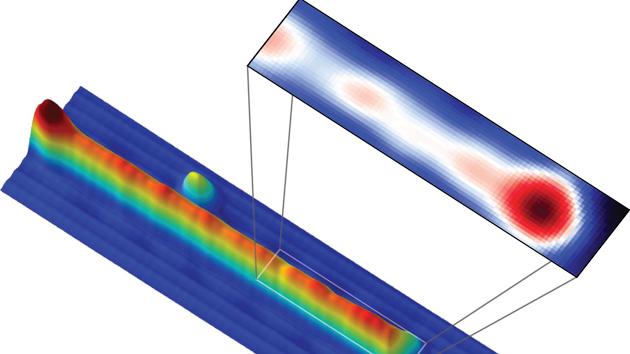antimatter
Latest

Quantum 'hashtags' may prove the existence of a strange particle
Hashtags could soon be useful for a lot more than fostering discussion on your favorite social network. Researchers have developed a hashtag-shaped quantum chip (shown below) that could confirm the existence of the oddball Majorana particle, which exists as both matter and antimatter at the same time. The team has learned that laying indium phosphide nanowires in the familiar '#' shape creates a closed circuit that lets the particles pass by each other and braid, rather that annihilating each other like they would on a single wire. Think of it like creating streets with intersections instead of a one-lane road -- the 'traffic' can actually get around without collisions.

ICYMI: Physicists just cracked a big anti-matter hurdle
Today on In Case You Missed It: CERN scientists announced they were able to measure anti-matter on the optical spectrum after a full 20 years of trying. This could not only help us understand the universe better but probably solve the mystery of the aliens everywhere meme-- kidding! That guy is unexplainable. Meanwhile Stanford scientists were able to see how starfish larvae move through water, creating vortices to both swim and move food closer to their mouths, something that had previously been unknown. If you're looking for a laugh, feel free to check out synthesizer bike guy, round two. As always, please share any interesting tech or science videos you find by using the #ICYMI hashtag on Twitter for @mskerryd.

Physicists learn how to measure antimatter
As you might guess, measuring antimatter is rather tricky: it's destroyed the moment it comes into contact with regular matter, so conventional approaches just aren't going to cut it. Give credit to CERN, then, as its Alpha group just measured antimatter for the first time. The team stuffed positrons (positively charged electrons) and antiprotons (protons with a negative charge) into a vacuum tube to create antihydrogen, with a "magnetic trap" keeping a small number of the anti-atoms in existence for long enough to measure them. The team then blasted the antimatter with a laser to study its positrons as they shifted energy levels, producing a spectral line.

The Large Hadron Collider is back and stronger than ever
Yes, it's back -- after a two-year upgrade program, CERN's Large Hadron Collider is once again operational. Scientists are only firing collision-free proton beams right now to test the new system, but they'll ramp up over the next few months to the point where they're smashing protons together at 13 teraelectronvolts -- about twice the energy the LHC managed in its first season. The machine will have a relatively short three years to operate before its next shutdown, but the higher output should help researchers explore antimatter, dark matter and other aspects of physics that are relatively untested. Given that the collider appears to have discovered the mysterious Higgs boson during its first run, we're hopeful that its second season has more breakthroughs in store. [Image credit: CERN]

Photography and the subatomic world collide in a new documentary
First it was Andy Warhol's obsolete digital archives and then the Lunar Orbiter Image Recovery Project. Now, the Hillman Photography Initiative's documentary team has set its sights on the CERN physics laboratory in its newest film, Subatomic. Famously known for housing the Large Hadron Collider (LHC), this facility is also home to the AEgIS experiment and the ATLAS Detector, one of the world's largest digital cameras. The scientists there use a variety of photographic technologies, from a cutting-edge 100-megapixel sensor that captures 600 million pictures per second, to antimatter experiments that use traditional photo emulsion to track particles. CERN even has an artist in residence program, showcasing outsider perspectives on the scientific world. These are all captured in this fifth and final installment of The Invisible Photograph film series from the Carnegie Museum of Art (CMOA) and Hillman Photography Initiative, which seek to reveal the hidden aspects of images whether obscured, lost or forgotten. Subatomic: The European Organizaton for Nuclear Research debuts online today, and you can watch the latest film below or stream the entire series on CMOA's website.

Newly discovered particle is both matter and antimatter at the same time
You probably think of matter and antimatter as mortal enemies, since their equivalent particles (such as protons and antiprotons) normally destroy each other on contact. However, there are now hints that the two might get along just fine in the right circumstances. Researchers claim to have successfully imaged a Majorana particle, which exists as both matter and antimatter at the same time. The team created it by placing a string of iron atoms on top of a lead superconductor, forming pairs of electrons and antielectrons -- except for one lone electron at the end of the chain, which exhibited properties of both.

University of Michigan activates antimatter 'gun,' cartoon supervillians twirl moustaches anew
At the University of Michigan, an international team of physicists has begun experimenting with its tabletop-sized super laser, modding it into an antimatter "gun." It's not quite a black hole-firing pistol, but we're slightly terrified nonetheless. Up until now, machines capable of creating positrons -- coupled with electrons, they comprise the energy similar to what's emitted by black holes and pulsars -- have needed to be as large as they are expensive. Creating these antimatter beams on a small scale will hopefully give astrophysicists greater insight into the "enigmatic features" of gamma ray bursts that are "virtually impossible to address by relying on direct observations," according to a paper published at arXiv. While the blasts only last fractions of a second each, the researchers report each firing produces a particle-density output level comparable to the accelerator at CERN. Just like that, the Longhorns/Wolverines super-laser arms-race begins again.

AMS detects excess of positrons, could suggest existence of dark matter
We've been waiting with bated breath all afternoon to find out what NASA, MIT and the Department of Energy has observed with the Alpha Magnetic Spectrometer. Well, we still don't quite understand the exact nature of dark matter, but highly precise measurements of positron fraction (the ratio of positrons to electrons and protons) do bring us a small step closer to proving the existence of the theoretical material. The AMS found a small excess of positrons coming from all directions instead of a single source. That could indicate the presence of dark matter, which is believed to generate the antimatter particles when it collides and annihilates itself. As usual though, this is far from conclusive. The excess of positrons could be caused by a number of cosmic phenomenon, including pulsars, but researchers are hopeful that further testing will narrow down the possibilities. Those of you hoping for direct and obvious evidence of dark matter may be a little disappointed, but let's be honest -- you were being overly optimistic. Besides, don't you want some mysteries left to solve? For more information, check out the PR after the break.

PSA: Watch the AMS dark matter results announcement at 1:30PM ET (video)
The universe is thought to be composed of stuff, non-stuff and maybe some other stuff. We're referring, of course, to matter, anti-matter and as-yet illusive dark matter. While we know a fair amount about matter and its opposite, dark matter is still largely theoretical. That might change in around half an hour, though, as folks from NASA, MIT and the US Department of Energy hold a press conference to explain exactly what the Alpha Magnetic Spectrometer (AMS) strapped to the ISS has been seeing during almost two years of space-scanning. Samuel Ting from MIT, who will be on the panel, implied back in February that today's results will provide the first evidence of dark matter's existence -- if that's the right term. The press conference is due to start at 1:30PM EDT, so make sure to tune in to the NASA TV livestream embedded below for what could be the biggest scientific news since Higgs and his boson. [Image Credit: NASA]

Antimatter gets trapped for 15 minutes by CERN scientists, escapes unharmed
Antimatter particles are elusive little critters that tend to disappear moments after being spotted. Unless, it turns out, you trap them in a "magnetic bottle" and turn the temperature right down to almost absolute zero. CERN scientists have now used this technique to hold 300 antihydrogen particles for up to 1,000 seconds, relaxing them into their ground (stationary) state to make them easier to study. This opens the way for further research later in the year, when captured particles will be prodded with lasers and microwaves to see if they obey the same laws of physics that govern everything else in our universe. After all this effort, we're quietly hoping they don't. [Thanks, Howard]

Universe expansion: dark energy's out, anti-gravity's in, matter and antimatter still can't get along
Dark energy, we barely knew you, but before we ever found out if you were, in fact, the invisible hand pushing the cosmos apart, an Italian scientist ginned up a new theory that has anti-gravity doing the Yoko Ono to the universe's merry band of galaxies. Massimo Villata's theory assumes that both matter and antimatter have positive mass and energy density, which gets particles attracting particles and antiparticles attracting antiparticles through the force of gravity. To give dark matter the heave-ho from the galactic expansion equation, Villata supposes that the theory of general relativity applies in reverse to antimatter particles to create anti-gravity. And just as gravity pulls particles together, anti-gravity shoves them apart -- giving the universe its burgeoning waistline, no clown, king, or colonel required.

$2 billion antimatter detector to go on last shuttle mission, taxpayers agree it better find -something
The airspace above the Atlantic Ocean will get a lot more expensive tomorrow as a U.S. Airforce Galaxy jet transports the Alpha Magnetic Spectrometer -- developed at CERN -- from Geneva to the Kennedy Space Center in Florida. The last-ever Space Shuttle mission in February will transport the AMS to the International Space Station, where it will stay docked for 20 years to "search for antimatter and dark matter by measuring cosmic rays." We're not sure what that means, but we trust it will lead to a microwave that heats the interior of our Hot Pockets while keeping the crust crisp and flaky, bringing us one step closer to World Peace.[Image credit: US Mission Geneva's flickr]

Researchers fire most powerful antimatter beam ever
Scientists at North Carolina's PULSTAR nuclear reactor facility fired a positron bean five times stronger than any other ever created earlier this month, breaking a record previously held by a team in Germany. The antimatter device -- which apparently looks like a Star Trek warp reactor -- was developed as part of a two year project by NC State, the University of Michigan, and Oak Ridge National Labs. Now that the device is working, the team is looking for practical applications for the tech, including building an "antimatter telescope," which would allow even closer observations of atomic interactions. Or they could use it to blow up the universe. You know, whatever.[Via TG Daily]








